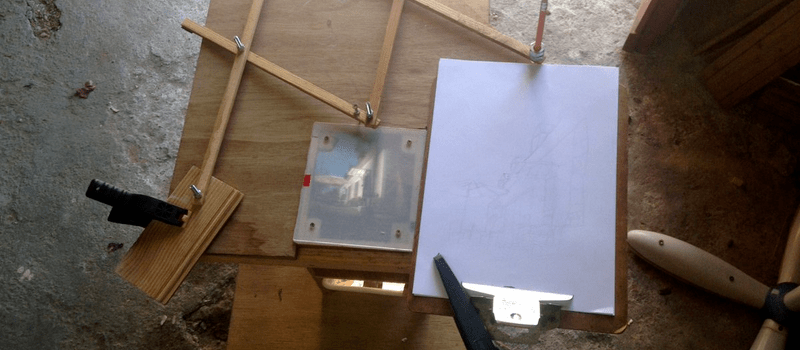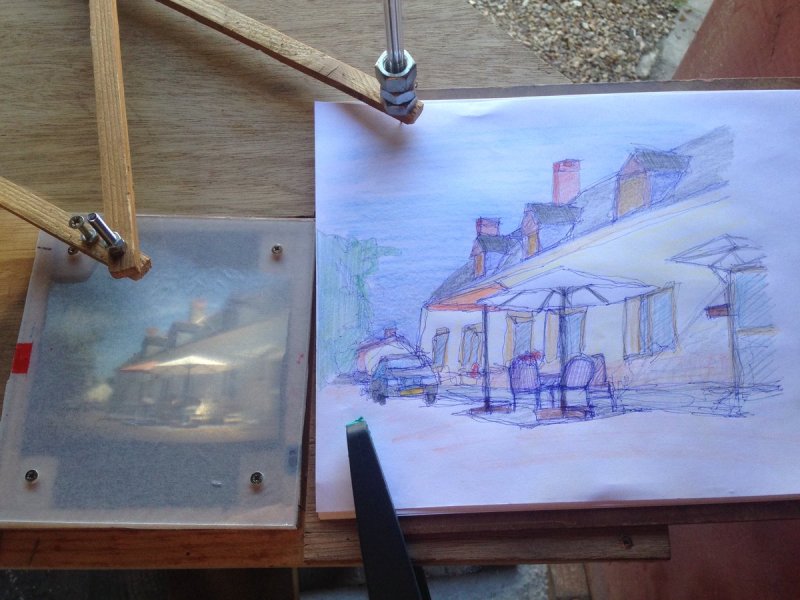Taking a picture is as simple as tapping a screen. Drawing a memorable scene, even when it’s directly in front of you, is a different skill entirely. So trace it! Well, that’s kind of hard to do without appropriate preparation.
[bobsteaman]’s method is to first whip up a pantograph — it tested well with a felt marker on the end. Next, he built a camera obscura into a small wood box with a matte plexiglass top, which didn’t work quite so well. A magnifying glass above the camera’s pinhole aperture helped, but arduous testing was needed to ensure it was set at perfect position for a clear image. The matte plexiglass was also thrown out and, after some experimentation, replaced with a sheet of semi-transparent baking paper sandwiched between two pieces of clear plexiglass. The result is hard to argue with.
Bundled into a drawing table, this camera obscura is fitted with a mirror underneath at a 45 degree angle so it projects up to the underside of the plexiglass. A blunted nail and a pen in the pantograph’s joints duplicate whatsoever the camera is capturing. For now, [bobsteaman] is forced to cart it around in the trunk of his car to capture the charming scene of his desire, but can also be handily busted out to entertain guests.
The camera obsucra is an ancient technology, but its use extends from observing the recent eclipse to actually taking pictures!
[via /r/somethingimade]

















You can do a modification of this where there is a sheet of Plexiglas attached to the pantograph and it just has a small dot on it. This lets you look at the scene without the wooded parts actually travelling over it. The motion is the same, it is just offset.
As for why you would bother, now that AI can paint a photograph with any style you want extracted from another image, I cannot say.
Purdue University decided to honor a member of the board of trustees with a painting made from a photo, by a computer. At the unveiling the gasps sound around the room. A real painter was hired to “touch-up” the offending image. He painted me in a 6 hour setting. IT, can’t come close.
AI will suckle your grand children. Then what.
Good for getting scale and proportion right, then freehand should give better results.
Hah, want a bet?
https://www.youtube.com/watch?v=vmkqFRyNUWo
Man, that’s positively creepy.
github: https://github.com/alexjc/neural-doodle
you can tweet an image to them. See here: http://www.creativebloq.com/digital-art/deep-forger-photos-works-art-121518372
Neural network – yes but no not an AI. Stick to ML as a descriptior IMHO.
cool stuff, even beautiful, but such images are almost always flawed because the program lacks full understanding of what it is re-drawing. Like the fox in the thumbnail of the youtube video. No fox I’ve ever seen is consistently that fuzzy all over and the ear fur is wrong. There’s something weird about the nose too. The whole experience is like being trapped in a Star Trek holo-deck and becoming aware of it by noticing impossible flaws in your “reality”. Inquisitive minds are particularly inclined to disbelieve what they see since they are naturally drawn towards irregularities. Still its way cool and well worth doing more of.
You could modify this by adding a 2D digital detector powered by a Raspberry Pi, and a lens from an old camera. It could be the CameraPi and sweep the world! In fact, then you won’t even have to draw anything!
Nice. Any excuse to sit and take in a scene is worth it, rather than point, click and more time in front of the confuser.
A Camera Lucida is more compact
http://chestofbooks.com/crafts/scientific-american/Recipes/images/The-Camera-Lucida.jpg
They have these on Kickstarter, too. Check out: http://neolucida.com/
They have those in art supply stores.
What’s a store?
They are not in art supply stores. That’s why there is a kickstarter. Some antique versions are available on e-bay as are some that the neolucida makers did on their previous kickstarter.
Sure they’re available in stores. Lee Valley has Camera Lucidas in stock, even in my podunk little burgh. http://www.leevalley.com/en/wood/page.aspx?cat=2,40725&p=72293
Much of kickstarter is just rehashing of old ideas without checking whether said product is already available – or deliberately omitting that it is available to make it seem like you can’t get it elsewhere.
It’s also trivial to make a serviceable camera lucida out of a hand mirror and a piece of glass.
I got one of the original Neolucidas. It’s too small to be usable if you wear glasses, and very tiring holding your head in exactly the right position to view through it without bumping it out of position. The new XL version looks like it’s solved the glasses problem at least.
Never used one, but it seems like you’d want a small window, to avoid parallax errors from having your eye in different places. The corollary, then, is that you’d want one with a sturdy mount that locks in position, and has a brow rest to steady your head against. (And contact lenses, of course.)
The pictures on their website seem to show tracing flowers placed at a similar distance as the paper, and thus wouldn’t be much affected by parallax; using it to trace objects at greater distances seems like it could be a problem for the XL.
Tim’s Vermeer this article reminded me of the extraordinary lengths 1 bored man went to.
https://www.youtube.com/watch?v=CS_HUWs9c8c
May be expensive but you can buy ground glasses for large format camera online. They probably give better resolution. Also a fresnel in front of the “ground glass” if done right can help even the brightness around the outside.
What’s wrong with a photo ?
If the scence was worth capturing its worth capturing as accurately as possible why introduce distortion?
What do you think creates more lasting memories of a place: one you’ve taken a picture of, or one you made a drawing of using this device?
We’ve never taken more photo’s in history, and never cared less about them, or looked less at them later.
I get the impression (sorry) that it’s more an exercise in the relief of boredom than a way ofcapturing an image.